The process of an ecommerce mobile app development involves designing a seamless user interface, integrating secure payment gateways, and optimizing performance. Discover the steps involved while developing a well-designed ecommerce app and capitalize on the opportunities in the digital marketplace in this blog.
Successful Mobile App Development in Ecommerce
According to Statista, mobile eCommerce sales are projected to exceed $432 billion in 2022, showing significant growth from $148 billion in 2018.
Mobile app development necessitates collaboration with experts from various fields, including a team member possessing expertise in the specific sector of the ecommerce business for which the app is being developed. Entrepreneurs and new businesses often encounter dilemmas and struggle with questions such as:
- What factors should be considered before commencing the development process?
- What kind of technology partner should be sought?
- How can responsibilities be shared effectively?
- Which essential features are important in the initial development phase?
Here are the steps presented below, in a sequential manner, to guide you through the process smoothly and ensure a hassle-free experience:
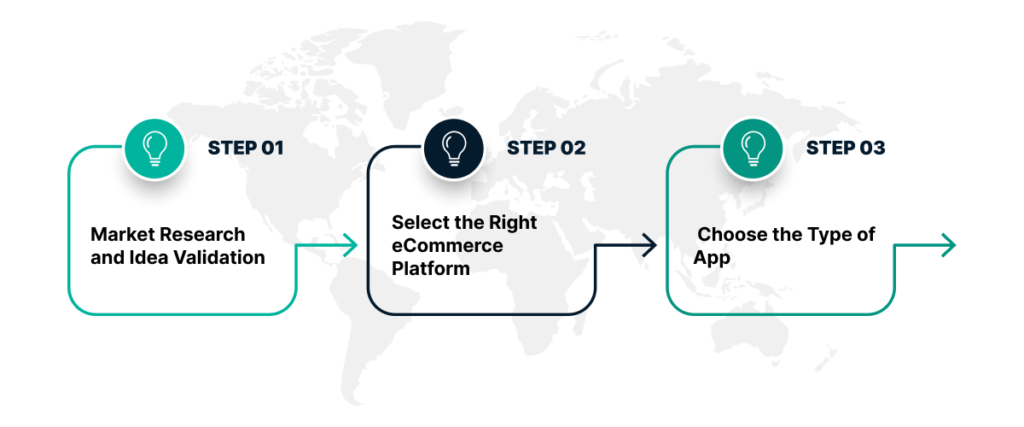
Step 1: Market Research and Idea Validation
The first step is to undertake market research and document the requirements, and ideas that would best address the current concerns and market gaps. The last thing you’d want to do is to go to market with an idea that reflects a poor understanding of your intended target audience.
Once market research confirms the feasibility of your business idea, create a comprehensive plan outlining your desired features. It’s likely that the market research may even better inform the initial concepts envisioned for the app.
Having a well-structured plan is essential to ensure an organized and efficient development process. By adhering to a well-defined plan, you can expedite the completion of tasks and achieve better results.
To effectively communicate your needs to the design team, it is suggested to record all design and development-related details. Typically, the list should include the following elements:
-
- Needs and objectives of the project
-
- Overview of the entire project
-
- The target audience for the app includes your Ideal Client Persona and their typical purchasing behavior
-
- Include necessary features
-
- Non-functional requirements
-
- Restrictions and recommendations
-
- Questions and queries about the project.
There are various platforms available for ecommerce app development, such as Magento (open-source)/Adobe Commerce, Shopify, BigCommerce, and WooCommerce.
Step 2: Select the Right Ecommerce Platform
Before deciding on the technology to use for ecommerce application development, it is crucial to have a thorough understanding of your business. Consider factors such as development cost, and inventory management, and select a suitable content management system (CMS), database, and scalable framework.
Additionally, taking into account the platform used for your main ecommerce site ensures better synchronization and integration between your website and the mobile app, providing a seamless user experience.
With this information, you can make a good decision on whether to launch an Android app, an iOS app, or both, based on the mobile phone platform your target audience is predominantly on.
Choice of Tech Stack
The choice of tech stack plays a vital role in transforming a good idea into a successful product. The tech stack comprises various components, including:
-
- Frontend: The user interface (UI) of the app.
-
- Backend: The server-side processing.
-
- Development: The platform with libraries and interfaces.
-
- Supporting: Technologies that ensure app security and performance.
For example, When developing an Android ecommerce app, considerations include:
-
- Programming Language: Java or Kotlin for Android.
-
- App Development Tools: Android Studio.
-
- UI Framework: Jetpack Compose.
-
- Android UI.
Similarly, for iOS app development, consider:
-
- Programming Language: Objective-C or Swift.
-
- iOS Mobile Development Tools: Xcode, AppCode.
-
- UI Frameworks: UIKit or SwiftUI.
For cross-platform apps, the following programming tools are commonly used:
-
- React Native (JS).
-
- Flutter (Dart).
-
- Xamarin (C#).
Step 3: Choose the Type of App
After understanding the target users and the app functionality, the next step is to find the app type required for the ecommerce platform. In this context, two options stand out as the most suitable:
Progressive Web Apps (PWAs)
-
- PWAs, or Progressive Web Apps, are websites designed to perform like mobile phone applications with enhanced agility and performance.
-
- Unlike Native apps, they do not require downloading from the app store and are accessible through web browsers with an internet connection.
-
- PWAs are a cost-effective choice. Especially, when budget limitations exist and the ecommerce platform already enjoys significant traffic.
Native Apps
-
- Native apps are traditional applications that need to be downloaded from app stores and are specifically developed for platforms like Android and iOS.
-
- They offer greater flexibility in UI/UX customization and leverage the best features of mobile devices, such as access to the camera, photos, and an interactive interface.
-
- Native apps also allow the application to function offline, enhancing the appeal of the ecommerce store and providing valuable customer behavior and preference data for service and product refinement.
Hybrid App
-
- Hybrid app development combines elements of web and mobile native apps, offering the benefits of both approaches.
-
- With this approach, developers leverage HTML to build the core of the software and then wrap it with a native device wrapper for iOS or Android.
-
- This allows hybrid apps to be downloaded from app stores while relying on HTML rendered in a browser.
-
- Some ecommerce companies opt for hybrid solutions as wrappers for existing web pages, reducing time-to-market and project costs.
The decision among Hybrid, PWAs, and Native apps hinges on the desired user experience and functionality of the ecommerce store. Both options offer opportunities for customization and scalability.
Protip: Working with a technology partner offering custom app development services enables harmonizing your vision and good ideas to create the desired end product for your customers.
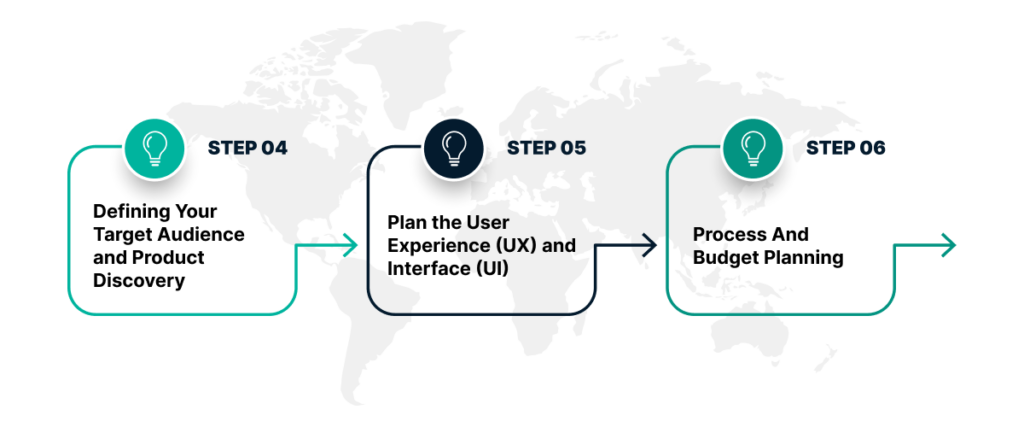
Step 4: Defining Your Target Audience and Product Discovery
Product discovery involves studying and defining the target audience, understanding their requirements and expectations, and leveraging this information for efficient and profitable application development.
Effective communication between the team and the ecommerce app development company is crucial during this stage. When handing the project to a skilled development team, the following steps are included:
-
- Discussion within the in-house team to ensure the needs of the ecommerce app development company are fully understood.
-
- Conducting competitive market analysis to gain insights and stay ahead of competitors.
-
- Setting appropriate deadlines based on the complexity and requirements of the project.
This collaborative approach ensures that the entire team, including the product manager, UI/UX developer, solution engineer or architect, and other necessary experts, work together towards a successful outcome.
Step 5: Plan the User Experience (UX) and Interface (UI)
It is crucial to prioritize ecommerce UI/UX design to elevate the ecommerce experience beyond traditional in-person shopping.
-
- This design aspect plays a vital role in setting your business apart from others.
-
- It serves as your business voice, presenting your brand to customers.
-
- By incorporating smooth transitions, captivating color schemes, and visually appealing elements, you can instantly captivate the attention of customers when they land on your application.
-
- The design of your application can make or break the first impression, so it is essential to prioritize and perfect this feature to create an exceptional user experience.
To create an outstanding ecommerce app, consider incorporating the following design elements:
-
- Microinteractions
-
- Animated illustrations
-
- Storytelling
-
- Broken grids and asymmetrical layouts
-
- Bold typography
These design elements can greatly enhance the visual appeal and better user engagement of your ecommerce app, making it more engaging and captivating for your customers based on their typical user behavior.
Step 6: Process And Budget Planning
Depending on various factors. the app development cost can vary significantly, ranging from $15,000 to $135,000 or more. Let’s explore the variables that can influence this equation.
App Features
-
- App features play a significant role in determining the cost. The more extensive and complex the features you want to incorporate, the higher the cost will be.
-
- It includes both technical functionalities and design elements.
-
- Innovative and intuitive designs require more development hours, thereby increasing the overall cost.
-
- Additionally, pursuing high-quality goals can further contribute to the cost per hour.
The choice of developers also impacts the cost.
-
- Hiring a development team from a specific region can significantly influence the cost.
-
- Different regions have different pricing structures and expertise levels. Each team may provide a unique pricing model.
-
- It is essential to consider the pros and cons of hiring teams from various regions and determine what works best for your needs and budget.
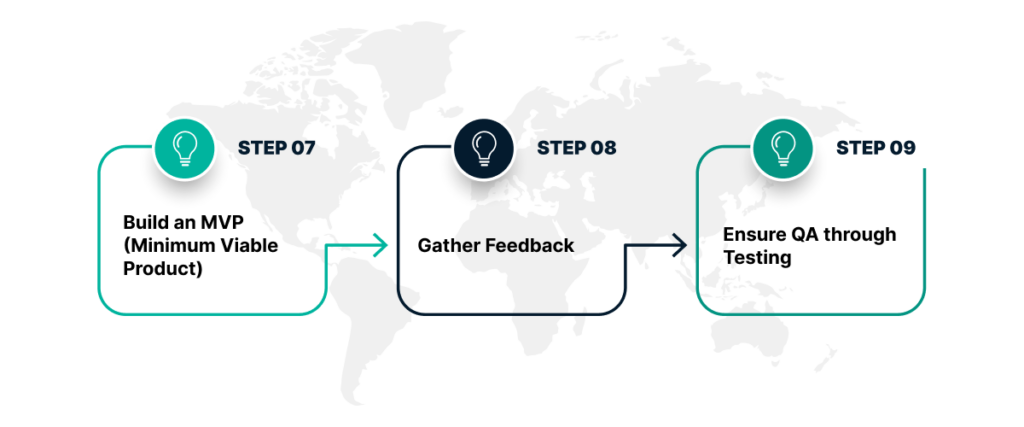
Step 7: Build an MVP (Minimum Viable Product)
Creating a minimum viable product (MVP) is an essential step in ecommerce mobile app development. An MVP is a scaled-down version of your app that includes its core functionality and allows for testing and validation. By developing an MVP, you can save time and resources while gaining valuable insights.
Primary Functionality:
-
- An MVP focuses on delivering the primary function of your app.
-
- Allows initial or test users to interact with the core features and experience the value proposition of the app.
-
- You can launch the app quickly and start gathering feedback by prioritizing essential functionalities.
-
- Developing an MVP helps reduce costs and time compared to building a fully-featured app from the start.
Iterative Development:
-
- The feedback gathered from users during the MVP stage serves as a valuable foundation for future iterations.
-
- By implementing user suggestions and addressing pain points, you can enhance the user experience.
-
- Prioritize features that resonate with your target audience, and optimize the app’s overall performance.
Step 8: Gather Feedback
After developing the MVP, it is essential to get feedback from real users/customers. Here are some effective methods to achieve this and reach your target audience:
-
- Beta Testing: Engage a group of beta testers who closely represent your target audience. They can provide valuable insights and suggestions for improvement. Consider selecting beta testers from your existing customer base or through specific recruitment channels.
-
- User Surveys: Create and distribute user surveys to collect feedback on various aspects of the app, such as usability, features, and overall satisfaction. Include open-ended questions and honest feedback to encourage detailed responses and quantitative questions to gather measurable data.
-
- Focus Groups: Organize focus groups comprising members of your target audience. Conduct moderated discussions or interactive sessions to gain deeper insights into their preferences, pain points, and suggestions. This direct interaction allows for in-depth feedback and encourages collaboration.
-
- In-App Feedback: Incorporate an in-app feedback feature that enables users to easily provide feedback directly from within the app. This could be in the form of feedback form, ratings, or comments. Prompt users at strategic points in their app journey to ensure timely feedback.
-
- App Store Reviews: Regularly monitor user reviews and ratings on app stores to understand user sentiment and identify areas for improvement. Respond to user reviews promptly, address concerns, and express gratitude for positive feedback.
-
- Analytics and User Behavior Tracking: Utilize analytics tools to gather quantitative data on user behavior, such as session duration, conversion rates, crashes, non-fatal exceptions, and popular features. Combine this with user behavior tracking to analyze user flows and identify areas that may require optimization.
Engage with your target audience, gather their feedback, and make informed decisions to enhance your ecommerce mobile app. Remember to prioritize user feedback and continuously iterate based on their insights to create a truly customer-centric app experience.
Step 9: Ensure QA through Testing
It is essential to include a comprehensive testing process as part of standard app development procedures
This testing process should encompass:
-
- Load testing,
-
- Regression testing,
-
- Device testing,
-
- Performance testing,
-
- Responsiveness testing, and
-
- Usability testing.
Once the testing phase is complete and discovered issues are resolved, the app is prepared for launch on the selected app store(s).
It is crucial to have qualified testers within the team who can generate accurate and detailed quality documents based on the testing results. These documents play a vital role in establishing the credibility of the app when it is released on the app stores.
Recommended Read: Top 10 Mobile App Testing Tools
Types of Ecommerce Mobile Apps
Let’s explore more about ecommerce mobile apps that go beyond the user journey and payment methods, offering a wide range of functionalities and types of apps.
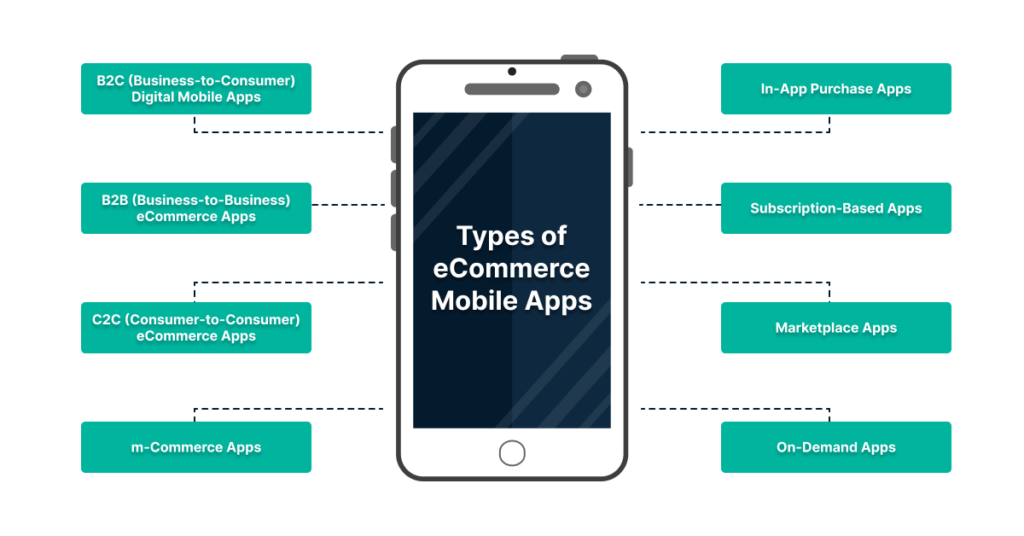
1. B2C (Business-to-Consumer) Digital Mobile Apps:
These apps are designed to facilitate the direct selling of goods and services from businesses to end consumers. They include various industries including fashion, education, electronics, and more. You can either create a comprehensive marketplace similar to Amazon or focus on a specific niche.
2. B2B (Business-to-Business) Ecommerce Apps:
B2B ecommerce apps serve to purchases between businesses. Platforms like eWorldTrade, allow companies and individuals to buy goods in large quantities. These apps can offer a wide scope of products and services catered to the B2B buyer journey. Sectors include industrial machinery and equipment.
3. C2C (Consumer-to-Consumer) Ecommerce Apps:
C2C apps enable customers to buy goods or products from other customers through third-party platforms. Popular examples include Etsy and eBay, where individual sellers can reach a wide range of potential buyers.
4. m-Commerce Apps:
m-Commerce apps allow users to shop and make purchases specifically using mobile phones. These apps are optimized for smaller screens and touch-based interactions, providing a user-friendly experience.
5. In-App Purchase Apps:
In-app purchase apps allow users to buy additional content, features, or virtual items within the app itself. This monetization method offers extra value to users, enhances engagement, and can be used with various payment methods.
6. Subscription-Based Apps:
Subscription-based apps require users to pay a recurring fee to access full functionality or content. They often offer a free trial or limited version before prompting users to subscribe. Examples include Apple Music, Netflix, and Hulu.
7. Marketplace Apps:
Marketplace apps connect buyers and sellers, creating a platform for trading goods or services. Similar to online marketplaces like Amazon or eBay, these apps facilitate transactions and enable users to buy and sell items. Examples include Uber, Upwork, and Fiverr.
8. On-Demand Apps:
On-demand apps, known as “Uber for X” apps, allow users to request and receive services or products in real-time. These apps provide convenient access to specific services without requiring prior planning. Examples include Glamsquad, Handy, and Rover.
9. Ecommerce Aggregator App
Aggregator ecommerce apps connect customers with service providers like Walmart and Etsy, allowing sellers to showcase and sell products directly through the app. App owners facilitate sellers without offering services or requiring infrastructure. Common components in app development ensure seamless functionality.
How Much Does it Cost to Develop an Ecommerce App?
The development cost of an ecommerce app varies based on the company and location. Here are the average hourly estimates in well-known software development countries:
- USA: $50 – $200
- Canada: $50 – $150
- Mexico: $40 – $120
- UK: $50 – $125
- Australia: $50 – $125
- India: $25 – $100
- Philippines: $25 – $75
Considerations for Developing a Mobile Ecommerce App
When developing an ecommerce app, there are key aspects that require special attention. Here are three important considerations to keep in mind during the development process:
Data Security:
Protecting user personal information is paramount. Safeguard their data from unauthorized access by implementing measures such as:
-
- Utilizing a private cloud for storing user information.
-
- Implementing encryption protocols to secure sensitive data, keeping it safe from prying eyes.
-
- Defining access rules, granting certain services only to premium subscription users.
-
- Implementing an alarm system to respond to any potential threats.
Versatility:
Ensuring your app can handle a growing user base is crucial. Although scalability may not be at the forefront during initial development, it is essential to forecast future growth and plan the app’s architecture accordingly.
Stability:
An unstable app with frequent crashes will diminish user experience and engagement. To achieve stability in app performance, consider the following steps:
-
- Conduct thorough QA testing.
-
- Iterate the product multiple times to address any issues.
-
- Gather feedback from users and make improvements based on their input.
-
- Regularly release updates to fix any identified issues.
Emerging Trends in Ecommerce Mobile App Development
Mobile commerce app is a thriving trend, making it a compelling reason to develop a mobile app for your ecommerce business. The growth of the mobile ecommerce industry continues to accelerate, as evidenced by the following noteworthy trends:
-
- In 2022, eMarketer predicts that Americans will spend approximately 88% of their mobile internet time within mobile apps, with the remaining time spent on web browsers.
-
- According to Statista, the U.S. witnessed mobile commerce sales exceeding $360 billion in 2012, and this is projected to nearly double to $710 billion by 2025.
-
- m-Commerce is set to become a dominant channel in online shopping, contributing 44% to the overall ecommerce sales, amounting to $488 billion by 2024. This represents a compound annual growth rate (CAGR) of 25.5% from 2019.
-
- The augmented reality (AR) and virtual reality (VR) industry is projected to reach $35 billion by 2025, with $1.6 billion of its potential allocated to the retail sector. Incorporating AR/VR features into a mobile application presents an excellent opportunity.
-
- According to Insider Intelligence, global consumer retail spending through chatbots is expected to rise to $142 billion by 2024.
These trends highlight the immense potential and value that a mobile app can bring to your ecommerce business, enabling you to tap into the growing mobile commerce app market and leverage emerging technologies to enhance the user experience.
Best Examples of Ecommerce Mobile Applications
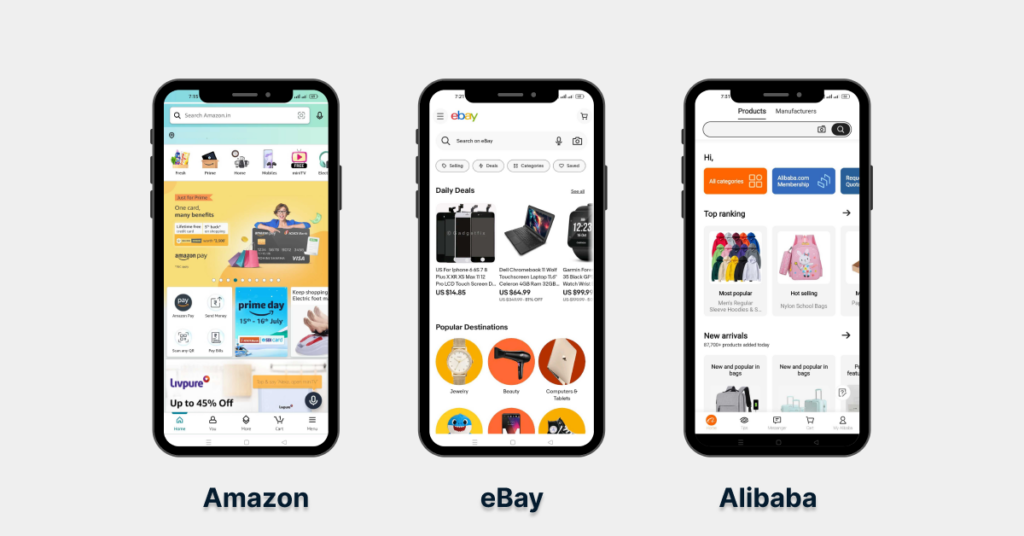
Amazon: The Amazon mobile app is a prime example of an eCommerce mobile application. It allows users to browse and purchase a wide range of products, track orders, and access personalized recommendations.
eBay: eBay’s mobile app enables users to buy and sell various items, participate in auctions, and manage their listings and transactions on the go.
Alibaba: Alibaba’s mobile app serves as a platform connecting buyers and sellers, offering a wide range of products from various categories such as electronics, fashion, and more.
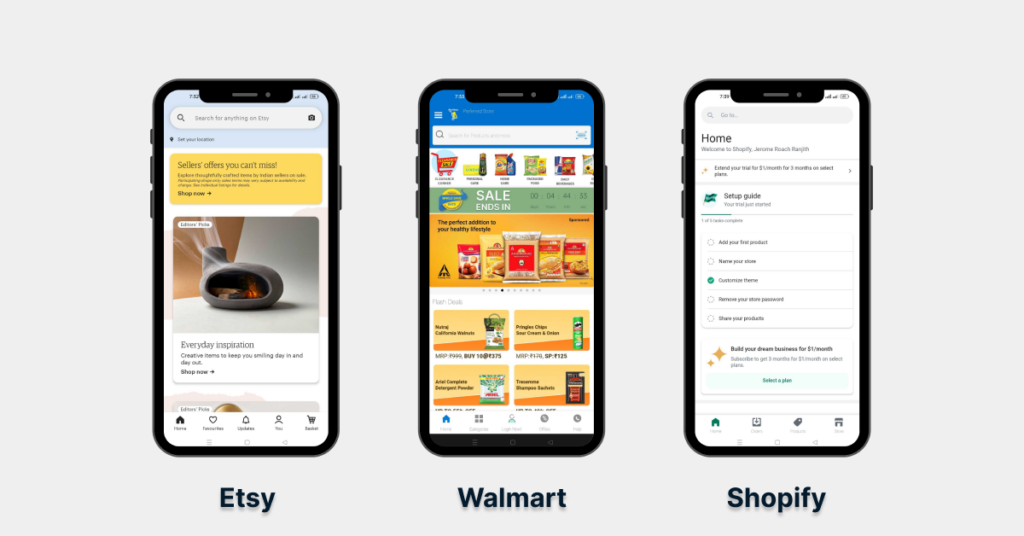
Etsy: Etsy’s mobile app focuses on handmade and unique items. Users can discover and purchase crafts, vintage goods, and customized products directly from independent sellers.
Walmart: Walmart’s mobile app provides users with a convenient way to shop for groceries, household items, electronics, and more. It includes features like in-store pickup, savings, and easy reordering.
Shopify: Shopify offers a mobile app that allows businesses to set up and manage their online stores. Users can customize their store, add products, process payments, and track sales and inventory.
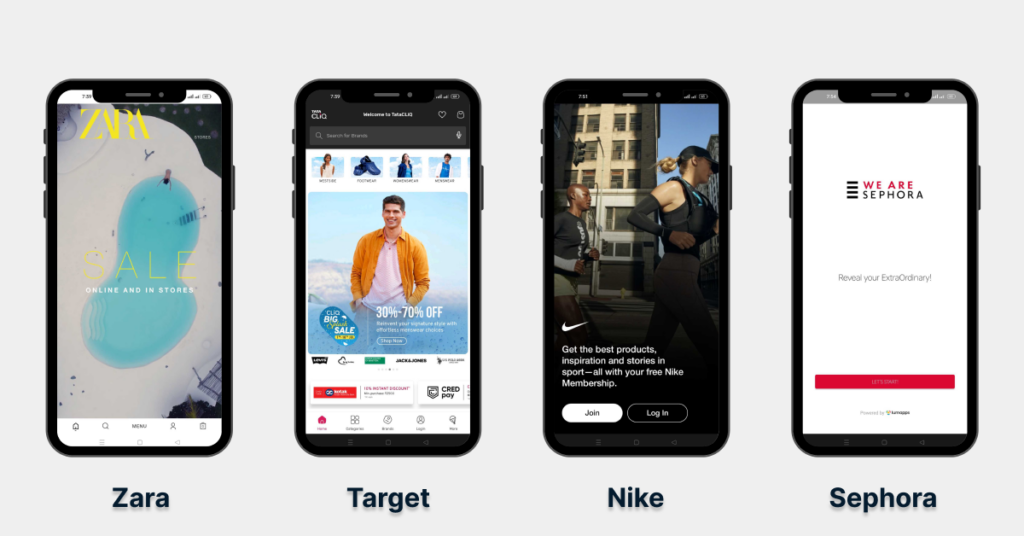
Zara: Zara’s mobile app showcases its fashion collection, allowing users to browse, purchase, and stay updated with the latest trends. It also provides features like size guides and in-store availability.
Target: Target’s mobile app offers a seamless shopping experience, providing access to a wide range of products, personalized offers, easy reordering, and convenient in-store services.
Nike: Nike’s mobile app focuses on providing a personalized shopping experience for athletic footwear, apparel, and accessories. Users can explore products, customize their shoes, and access exclusive content.
Sephora: Sephora’s mobile app allows users to discover and purchase beauty products, access product reviews, try on virtual makeup, and receive personalized recommendations based on their preferences.
These examples demonstrate the diverse range of ecommerce mobile applications available, catering to different industries and customer needs.
Benefits of Developing an Ecommerce App
1. Enhanced Customer Loyalty:
Creating an ecommerce app offers the advantage of strengthening customer loyalty and fostering stronger relationships with your customers.
2. Improved Speed:
Compared to mobile websites, ecommerce apps generally provide faster performance. Additionally, apps serve as efficient platforms for delivering timely notifications about new products, deals, and offers.
3. Personalized Content:
An ecommerce app is an effective means of delivering personalized content tailored to user preferences and interests.
4. Improved Access:
An ecommerce app enhances accessibility for customers, as it provides a convenient and easily accessible platform for shopping anytime and anywhere. With just a few taps on their mobile devices, customers can browse products, place orders, and make payments at their convenience, leading to higher customer satisfaction and engagement.
5. Improves Brand Recognition
Mobile apps build a strong connection between brands and customers by staying on users’ smartphones. Positive reviews on social media enhance brand reputation, while smooth service and attractive discounts foster customer loyalty. To create a lasting impression, prioritize high-quality and user-friendly UI/UX designs, promptly respond to customer queries, and leverage smart branding strategies.
Ecommerce Mobile App Development: Customer-Centric Solutions in the Digital Era
The widespread use of smartphones, the impact of the pandemic, the desire of consumers for new experiences, and other global circumstances have played a key role in the worldwide success of the ecommerce mobile app development industry.
While trends are key to observe and adapt to, the primary focus should be on the overall ecommerce app development process remains on prioritizing the customer and delivering a user-centric solution.
If you are planning to create an ecommerce app and require product support, Klizer is here to assist you. With over 18 years of experience, we possess the expertise to develop a tailored solution that serves your audience and product.
FAQs
What is an Ecommerce App?
An ecommerce app is a mobile application designed for online shopping, falling into different categories:
- Connection App: This type links users to a business’s online store or marketplace, like Amazon or eBay.
- Standalone mCommerce App: Operates as a standalone mobile commerce business, where products or services are exclusively available via the app without a corresponding website, as seen with Uber.
Given the expansive nature of ecommerce, these apps can cater to various business niches, such as online tutoring, on-demand home services, car rental, furniture rental, food delivery, and grocery delivery.
What is the impact of Mobile App Development on ecommerce businesses?
Mobile app development has a significant impact on ecommerce businesses, offering numerous benefits such as improved user engagement, expanded marketing opportunities, and enhanced customer experiences. These advantages contribute to increased revenue and exponential business growth.
What are the top tips for Ecommerce App Development?
Follow the below tips for developing a highly engaging and scalable app:
-
- Conduct Competitive Analysis: Research and analyze competitors in the ecommerce space to gain insights into industry trends, customer expectations, and potential areas for innovation. Differentiate your app by offering unique features or services.
-
- Emphasize Security: Prioritize the security of your ecommerce app to protect user data and build trust. Implement robust security measures to safeguard sensitive information.
-
- Streamline the Buying Process: Ensure a smooth and intuitive purchasing experience for users. Simplify the checkout process, minimize steps, and provide convenient payment options to enhance user satisfaction.
-
- Prioritize Scalability and Speed: Develop your app with scalability in mind to accommodate future growth. Optimize performance to deliver fast loading times and seamless navigation, even as the user base expands.
-
- Focus on App Functionality: Ensure that your app offers essential features and functionalities that align with the needs of your target audience. Prioritize core functions and gradually introduce additional features based on user feedback.
-
- Keep the App Simple: Strive for simplicity in app design and functionality. Avoid clutter and complex processes that may confuse or overwhelm users. Focus on delivering a straightforward and intuitive app experience.
-
- Engage Experts for Development: Collaborate with experienced professionals in app development to leverage their expertise and ensure a high-quality, error-free application.
-
- Create Robust Marketing Strategies: Develop effective marketing strategies to promote your eCommerce app and attract users. Utilize various channels such as social media, email marketing, and search engine optimization to reach your target audience.
What is the difference between custom ecommerce app development and ecommerce app builders?
Custom ecommerce development involves creating a unique app that tailors to the specific needs of a business, providing:
-
- Higher performance
-
- Customization options
-
- Robust backend support
On the other hand, ecommerce app builders are online platforms that provide pre-built templates and limited customization options, making them more affordable and quicker to launch but potentially sacrificing performance and flexibility.
Why do you need a mobile app for your online store when you already have a website?
Having a mobile app for your online app store is crucial because a large percentage of the population owns smartphones and spends a significant amount of time using them.
By providing a mobile app, you can reach customers directly on their mobile phones, offering convenience and accessibility. Mobile apps allow for a seamless and optimized user experience, enhancing customer engagement and potentially increasing sales.
What tech stack is required to make an ecommerce app scalable and performant?
-
- The tech stack for building a scalable and performant ecommerce app includes choosing the appropriate programming language based on the target platform.
-
- For Android, Java or Kotlin can be used, while Swift is suitable for iOS. Additionally, tools like Android Studio, Android Development Tools, XCode, and Appcode are used for coding and debugging.
-
- UI frameworks like Android UI, Jetpack Compose (Android), and UIKit or SwiftUI (iOS) are employed for designing and optimizing the user interface.
What are some key advancements in modern technologies that can shape the future of ecommerce mobile app development?
Absolutely! The future of eCommerce mobile app development is promising. Advancements in modern technologies like:
-
- AI, and ML
-
- Cross-platform development,
-
- Progressive web apps
-
- The Internet of Things, and 5G offer developers new opportunities to create innovative and transformative mobile apps.
These developments can revolutionize the way we engage in online shopping and enhance the overall user experience.
What are the key features to consider in ecommerce mobile app development?
Consider key features such as a seamless user experience, secure payment gateways, product search and filtering options, personalized recommendations, cart management, order tracking, push notifications, and social media integration.
Can you choose a custom-built app or ready-made software for ecommerce mobile app development?
The choice between a custom-built app and ready-made software depends on your specific business needs. A custom-built app offers more flexibility and tailored functionality, while ready-made software provides a quicker and more cost-effective solution. Consider your requirements, budget, and long-term goals to make the best decision.
How can ecommerce mobile apps benefit online businesses?
eCommerce mobile apps offer several benefits for online businesses. They provide a direct and convenient channel for customers to browse and purchase products, enhance customer engagement and loyalty, enable personalized marketing strategies, increase brand visibility, and tap into the growing market of mobile users.
What technologies are commonly used in ecommerce mobile app development?
eCommerce mobile app development commonly involves the use of technologies such as Java, Kotlin, Swift, Android Studio, Xcode, UI frameworks (e.g., Android UI, UIKit), and backend technologies for data management and integration with payment gateways and other systems.
How much does ecommerce app development cost?
The cost of ecommerce mobile app development can vary depending on various factors such as the complexity of features, platform compatibility, design requirements, development time, and the development team’s rates. It is recommended to discuss your specific project requirements with a mobile app development company to get a detailed cost estimate.
What role does a mobile app developer play in ecommerce mobile app development?
They are responsible for coding, implementing features, integrating APIs, ensuring app performance, and optimizing user experience. Their expertise in mobile app development languages and frameworks is essential for creating a functional and user-friendly ecommerce app.
Why is user experience important in ecommerce mobile app development?
It directly impacts customer satisfaction, engagement, and conversion rates. A well-designed and intuitive app with seamless navigation, fast loading times, and clear product information enhances the overall user experience, leading to better customer retention and increased sales.
How can social media integration benefit an ecommerce mobile app?
Social media integration in an ecommerce mobile app allows users to share product information, reviews, and recommendations with their social network. It can help in increasing brand visibility, attracting new customers through social referrals, and leveraging social media platforms as marketing channels for the app and digital products.
What are the best practices for ecommerce mobile app development?
When it comes to ecommerce mobile app development, it’s essential to consider various factors to ensure a seamless shopping experience for users. Following best practices and incorporating must-have features can significantly enhance the success of your app.
1. User-Centric Design: Focus on creating a visually appealing and intuitive user interface that enhances the shopping experience. Use clear navigation, intuitive product search, and easy-to-use filters to help users find what they need quickly.
2. Responsive and Mobile-Friendly: Ensure your ecommerce app is optimized for various mobile devices and screen sizes. It should offer a seamless experience across different platforms, including smartphones and tablets.
3. Fast Loading Speed: Optimize your app’s performance by minimizing loading times. Users expect fast and responsive apps, so optimize images, reduce unnecessary data requests, and implement caching techniques to improve loading speed.
4. Secure Payment Gateway: Implement robust security measures to protect users’ payment information. Use trusted and secure payment gateways and follow industry standards for data encryption and storage.
5. Personalization and Recommendations: Utilize user data and behavior analysis to offer personalized product recommendations and suggestions. Implement features like wishlists, saved searches, and personalized offers to enhance the user experience.
6. Streamlined Checkout Process: Simplify the checkout process to minimize cart abandonment. Enable guest checkout, provide multiple payment options, and offer one-click purchasing to make the process quick and hassle-free.
7. Seamless Integration with Backend Systems: Ensure smooth integrations of your app with backend systems, including inventory management, order processing, and customer support. This integration will enable real-time updates and accurate information for users.
8. Regular Updates and Bug Fixes: Continuously update your app to add new features, improve performance, and fix any bugs or issues. Regular updates show your commitment to providing a reliable and up-to-date app.
9. Analytics and Tracking: Implement analytics tools to track user behavior, engagement, and app performance. Utilize this data to gain insights, make data-driven decisions, and improve your app based on user feedback.
10. Ongoing Customer Support: Providing excellent customer support and utilizing cutting-edge technologies can elevate your app’s performance in the competitive world of electronic commerce.
By following these best practices, you can create an ecommerce app that not only meets user expectations but also drives customer engagement, conversions, and overall business success. It is crucial to carefully plan your app development process, keeping in mind the preferences of smartphone users and the global market.
By partnering with a leading ecommerce app development company, you can benefit from their expertise and create a custom-built app that caters to your business needs.
With advanced features and the integration of artificial intelligence, your app can provide a personalized and engaging experience for potential customers.
Whether you choose to develop native apps for specific mobile platforms or opt for a cross-platform mobile app, focusing on delivering a great user experience and incorporating the right set of features will undoubtedly contribute to the success of your online business.